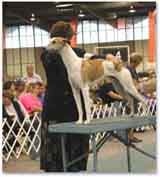Show Dog InformationInside The Ring: Part 1 |
|
|
When it comes to dog shows, word "handler" is the person actually in the ring with the dog. A "professional" handler would be a handler that shows dogs as his profession and he gets paid for being in the ring with the dog. You who are not familiar with the word may misinterpret some of these statements. When we say, "watch the good handlers," we do not necessarily mean the professional handlers. There are good handlers who are strictly amateurs. Along with the two main mistakes a novice exhibitor makes, that of holding the show lead in two hands instead of one, and of taking tiny, little mincing steps when gaiting his dog, there are many small things, not exactly mistakes, which should be pointed out to him in order to improve his handling. These are not in any particular order of importance, for when it comes right down to fine points, they are all important. When showing your dog, use a firm hand, firm but not rough. The rough handling, if you have a hardheaded dog, should be done at home during the training period, certainly not in the show ring. Occasionally it may be necessary to reprimand a dog in the ring if he seems to have forgotten all his training, but when it is necessary, you should speak harshly to him, perhaps using a few light taps where they will do the most good. A hard smack will give the judge and the spectators the impression that you do not love your dog, that the win is more important to you than the dog, and that you have done no training at home. The gasp that goes up around the ringside whenever a dog is loudly spanked in the ring, even though the dog is not hurt, will convince you that I am correct. It is necessary that you acquire a firm hand so that the dog knows what you expect of him. A wishy-washy touch with a dog is as bad as a wishy-washy handshake. The limp handshake might lose you an expected friend and a too-light touch with a dog might lose you an expected ribbon. Don't get down on both knees when you pose your dog. In order to get out of this position you must shift all your weight to one knee while you are bringing the other foot into position to stand on it. Frequently you lose your balance getting out of this position. However, sitting on your heels during a large class is better than having nothing to sit on, but in the long run you will find the position has more drawbacks than it has comfort. In showing a great many breeds you will be standing upright all of the time, but if you must get down lower, try the squat, or try placing only one knee on the ground and keep the other leg bent. Whichever you choose, keep your back as straight as possible. Either of these two positions allows you to get on your feet quickly and gracefully without the danger of losing your balance. See the Inside The Ring: Part 2 page Back to the Show Dog Information page
| |
|
Related News About Dogs ' ); // get rid of newsfeed display by carp CarpConf('poweredby',''); CarpCacheShow('http://www.petfriendlyworld.com/chat/index.php?action=.xml;board=16;type=rss'); ?>
|
|
|
|
|
|
Copyright © 2006-2007 dogguidance.com |


